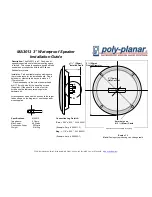
Doc. No.: 103839 Rev. A
jotron.com
Page 54 of 104
8.3.2.7
Alarm relay output
Picture to the right shows where to
connect external alarm to Transponder.
In this configuration, both the external
relay and the alarm unit are powered from
external power source, and the alarm unit
is grounded through the external relay if
an alarm occurs or the main power to the
AIS is removed or defective.
Other configurations may be used, but
remember that the Alarm must function
both on AIS Alarm conditions, and power
failure to the AIS.
The internal alarm relay is a normally closed earth free
relay contact, provided as an independent and simple
method for triggering an external alarm. This means
that when the transponder is powered and there are
no alarms, the contact is considered closed. If an
alarm occures or power is lost, the contact is
considered open, as also will be the case when the
wiring is incorrect or broken. The internal alarm relay
will close when the alarm is acknowledged. If
transponder power is lost or the wiring to the internal
alarm relay is broken, the only way to deactivate the
Alarm is to disconnect the power source of the Alarm
relay. The internal alarm relay is capable of driving a 2A
current. The maximum voltage over the internal alarm
relay must not exceed 48V.
The alarm relay is only activated for unacknowledged warning alerts. Caution
alerts does not affect the alarm relay. This is a change from IEC 61993-2 Ed2 to
Ed3.
# In/Out Type
Usage
Name
37
Out
Relay
(NC)
Alarm
ALARM_A
38
Out
ALARM_B
Figure 8-24 Typical Alarm connection
Summary of Contents for 103660
Page 1: ...Tron AIS TR 8000 MkII AIS Class A Inland AIS Transponder Operator and Installation Manual...
Page 2: ......
Page 103: ......
















































